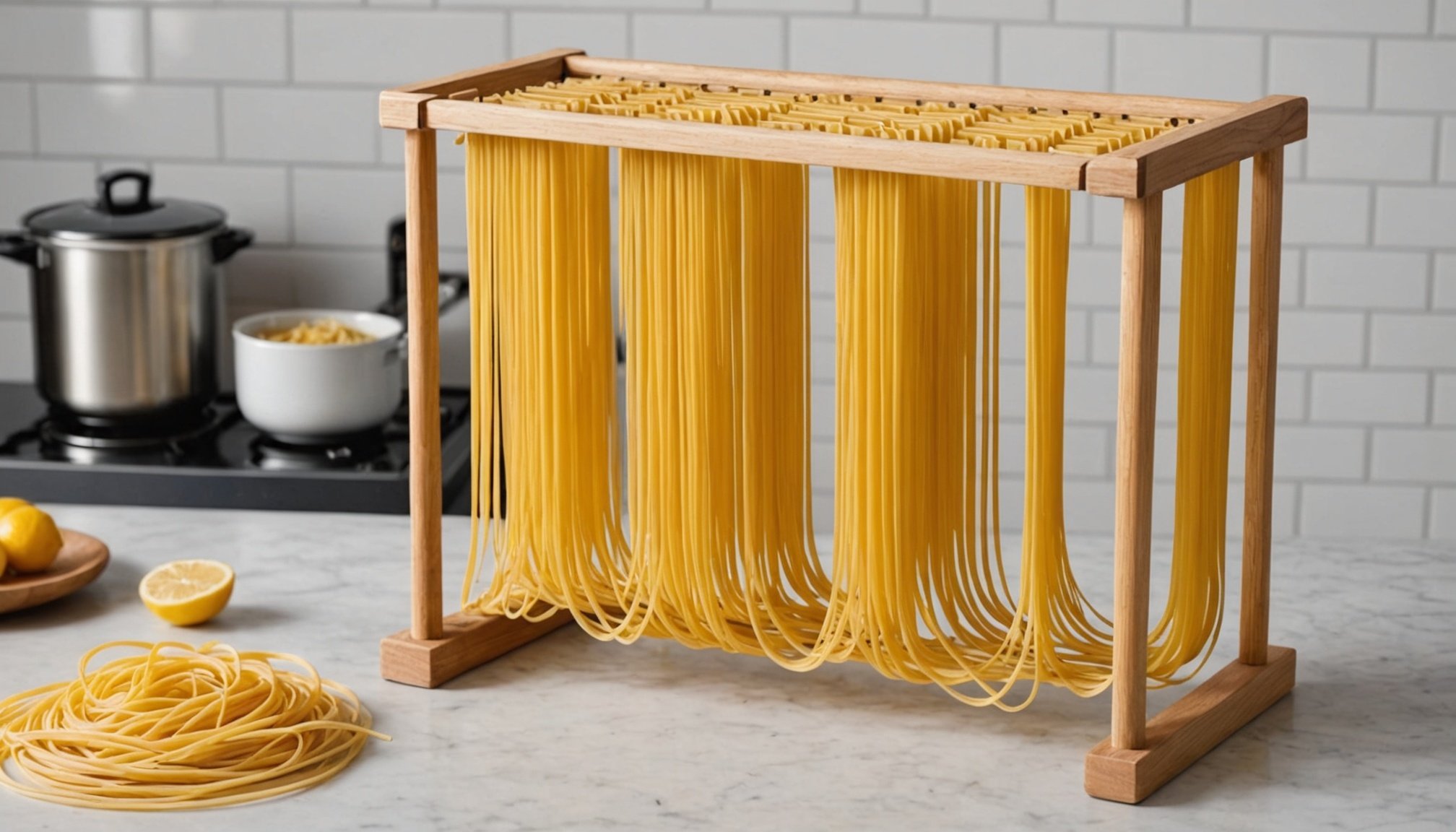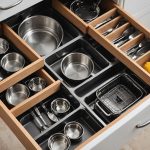Understanding Pasta Drying Racks
When considering pasta drying racks, it’s essential to understand the range of available types. These include traditional, collapsible, and multi-tier systems. Each type serves a unique purpose, and the best choice depends largely on your individual needs and kitchen setup.
Traditional pasta drying racks are often made from wood or metal and offer sturdy, reliable platforms for drying pasta strands. They are ideal for those who have ample kitchen space and prefer a classic look.
Also to discover : Essential Guide to Selecting the Perfect Sushi Rolling Kit for Beginners
On the other hand, collapsible pasta drying racks are perfect for kitchens with limited counter space. These racks can be easily stored away after use, making them a convenient option for those who value versatility and compactness.
Multi-tier models maximize drying space, allowing users to hang more pasta simultaneously. Such racks are designed with functionality in mind, integrating multiple levels to make the most of vertical space.
Also to discover : Discover the Most Durable Material for Your Drip Coffee Pot: A Guide to Longevity in Brewing
When assessing a pasta drying rack’s capabilities, consider the material and design. A well-designed rack, constructed from high-quality materials, can impact the drying process and durability. Additionally, ease of cleaning and assembly are critical features that determine the overall effectiveness of a pasta drying rack.
Factors to Consider When Choosing a Pasta Drying Rack
Selecting the right pasta drying rack involves evaluating various factors that suit your individual needs. Begin by considering the size of the rack. If you have a small kitchen, examine compact options or collapsible models that offer easy storage solutions. For larger kitchens, traditional or multi-tier racks could provide more drying capacity without compromising on space.
Durability is another crucial factor. Opt for racks constructed from high-quality materials such as stainless steel or hardwood. These materials ensure longevity and reduce maintenance efforts compared to alternatives like plastic. Additionally, they tend to support heavier pasta loads more effectively.
When assessing value, compare the price range of different models relative to their features. Some racks may come with additional accessories, such as integrated pasta cutters, which could enhance their utility, providing a greater return on investment. Paying slightly more for a rack with superior design and extra functionalities can often be worthwhile in the long run.
Lastly, consider ease of assembly and cleaning. A simple setup with parts that are easy to disassemble for washing will save effort and ensure better hygiene, contributing positively to your pasta-making experience.
Space-Saving Techniques for Pasta Drying
Integrating pasta drying racks into your kitchen design can help maximise kitchen space without compromising efficiency. Creative storage solutions allow racks to blend seamlessly into compact environments. Collapsible racks serve as excellent examples, folding away swiftly when not in use. This feature is particularly beneficial for small spaces, providing both functionality and convenience.
Incorporating vertical space is a wise strategy, best achieved through tiered drying systems. These racks elevate, stacking multiple tiers, which helps accommodate large amounts of pasta without occupying more counter space. The design not only saves space but also enhances the drying process by improving air circulation around each pasta strand.
To maintain an uncluttered kitchen while using a drying rack, consider these tips:
- Store rarely used items elsewhere, freeing up room for essential operations like pasta drying.
- Place racks near storage compartments to ease access and reduce the distance between drying and storage areas.
- Keep countertops reserved for frequently used items.
Employing these space-saving tips, you can ensure your kitchen remains organised and efficient, supporting a smooth pasta-making process. An optimal setup will encourage consistent use and contribute positively to your culinary endeavours.
User Reviews and Recommendations
Understanding user reviews can provide invaluable insights into which pasta drying racks live up to their promises. Based on customer experiences, traditional racks excel in sturdiness, appealing to those who prioritise robust construction. Feedback often highlights collapsible options as practical for smaller kitchens, valued for their space-saving functionality without compromising quality.
Consumers frequently commend multi-tiered racks for their expanded capacity, making them a preferred choice for households that often make larger batches of pasta. Top-rated racks typically score high in ease of assembly and cleaning, major plus points noted in several reviews.
An essential consideration from reviews is the balance between price and features. Consumers appreciate when a slightly higher price tag accompanies advanced functionalities and durability, suggesting a reliable long-term investment. Racks featuring integrated pasta tools often receive favourable mentions for added convenience.
Moreover, customer ratings consistently favour racks crafted from premium materials like stainless steel or hardwood. These materials not only enhance durability but also bolster user confidence in the product’s overall performance. Collectively, these insights from user reviews guide potential buyers towards making informed decisions, underscoring the importance of considering both functionality and user satisfaction.
Practical Examples and Visuals
Incorporating pasta drying racks effectively into your kitchen setup can seem daunting, but practical examples and visual aids provide valuable guidance. Visual comparisons highlight how different types of pasta drying racks fit into various kitchen arrangements, helping you choose the most suitable option for your environment.
A step-by-step guide proves instrumental in demonstrating the usage of a pasta drying rack. Begin by preparing your pasta and then carefully hang it on the designated arms or tiers, ensuring even spacing to promote optimal air circulation and drying. This method prevents pasta from sticking together and ensures a consistent drying process.
Real-life examples reveal creative placements for racks that optimise kitchen space. For instance, traditional wooden racks can be permanently stationed over large countertops, while collapsible models might nestle above cabinets when not in use. Utilising multi-tier racks against a wall maximises vertical space, efficiently accommodating larger batches.
Visual aids not only enhance understanding but also inspire creative organisation in kitchen spaces, ensuring pasta drying is both practical and stylish. By evaluating these scenarios, one can appreciate the functionality and aesthetic value that well-chosen pasta drying racks bring to culinary adventures.





